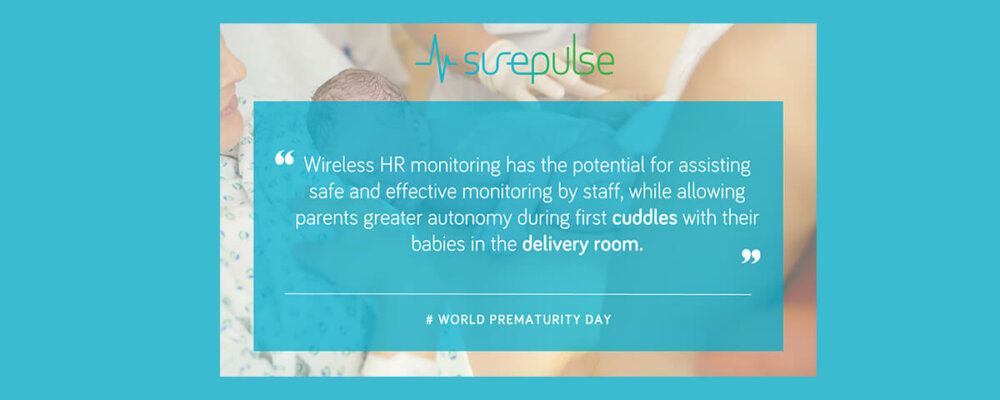Delivery room cuddles for premature infants
This World Prematurity Day, Friday 17th November, SurePulse is highlighting the benefits of delivery room cuddles for premature babies and their caregivers.
The journey of welcoming a newborn into the world is a profound and emotional experience for any parent. When a baby arrives earlier than expected, the initial moments become even more critical for both the infant and the family. The benefits of parental contact, through skin to-skin, kangaroo care, or family centric care (FIC) are well documented1. These methods have become increasingly popular in neonatal intensive care (NICU) settings; however this type of care is less routinely observed in the delivery room. The delivery room cuddle allows the mother to hold her baby before the baby is admitted to NICU. For many parents this may be the last opportunity to hold their baby for some time.
Advantages of the delivery room cuddle
Premature babies often face challenges in regulating their body temperature, heart rate, and breathing. Evidence suggests that parent’s skin during cuddling helps enhance physiological stability and reduce pain1,2,3. The intimate contact facilitates a comforting environment that aids in maintaining the baby’s physiological functions and promotes breastfeeding4.
The emotional connection between a parent and their premature baby is immensely important. Early cuddles have been shown5 to reduce maternal stress and have a positive impact on perinatal mental health. This early bonding lays the foundation for a strong emotional connection, fostering a sense of security and trust that is vital for the baby’s overall development. In a case study5 of parents who received delivery room cuddles, one stated ‘‘I remember the doctors bringing Lillie over and putting her on me…Holding Lillie changed everything – it made me feel much calmer. I can’t really explain it, it makes you feel complete, it makes you feel positive, as if everything could be OK.’’
Safety
An important consideration for delivery room cuddles is ensuring that the baby is stable, and it is safe for the infant to have a cuddle before undergoing further treatment. Vital sign monitoring during delivery room cuddles should be continuous and breathing equipment maintained6. It’s also very important that parents feel reassured, that their cuddle is in the best interest of the baby and is not putting them at additional risk.
SurePulse
The SurePulse VS Cap is a heart rate monitor which has been designed to provide clinical teams with accurate, reliable, and timely information in the critical moments after birth. The wireless nature of the SurePulse VS helps to reduce the number of wires on the baby, promoting cuddles in the delivery room. A recent study7 using the SurePulse VS found that ‘Wireless HR monitoring has the potential for assisting safe and effective monitoring by staff, while allowing parents greater autonomy during first cuddles with their babies in the DR.’
Conclusion:
In the delicate and often challenging world of premature birth, the advantages of delivery room cuddles for premature babies are immeasurable. Beyond the immediate comfort and warmth, these moments of intimate connection lay the foundation for a healthier and happier journey for both the baby and the family. As medical professionals increasingly recognize the importance of early kangaroo care and the technologies which can support it, it is essential for parents to embrace these early opportunities for bonding, ultimately contributing to the long-term well-being of their precious little ones.
References
1. Moore E, Bergman N, Anderson G, Medley N. Early skin-to-skin contact for mothers and their healthy newborn infants. Cochrane Database Syst Rev 2016;11:CD003519.
2. Boundy EO, Dastjerdi R, Spiegelman D, et al. Kangaroo mother
care and neonatal outcomes: a meta-analysis. Pediatrics.
2016;137:e20152238.
3. Campbell-Yeo ML, Disher TC, Benoit BL, Johnston CC. Understanding kangaroo care and its benefits to preterm infants. Pediatric Health Med Ther. 2015;6:15-32.
4. Moore ER, Bergman N, Anderson GC, Medley N. Early skin-to-skin contact for mothers and their healthy newborn infants. Cochrane Database Syst Rev. 2016;11:CD003519
5. Bates S., Edwards L., Peters C., Morrish P., Ashton K., Nicholas H., Sullivan C. Delivery room cuddles for preterm babies: should we be doing more? Infant 2019; 15(2): 52-56.
6. Clarke, P. et al. (2021) ‘Delivery room cuddles for extremely preterm babies and parents: Concept, practice, safety, parental feedback’, Acta Paediatrica, 110(5), pp. 1439–1449. doi:10.1111/apa.15716.
7. Myhill, J., Pocock, L. and Clarke, P. (2023) ‘Feasibility and acceptability of a novel forehead-mounted wireless heart rate monitoring device in preterm babies’, Oral Presentation at the Congress of joint European Neonatal Societies (JENS) 2023.
